A Beginner's Guide to Crafting Homemade Slime with Ease

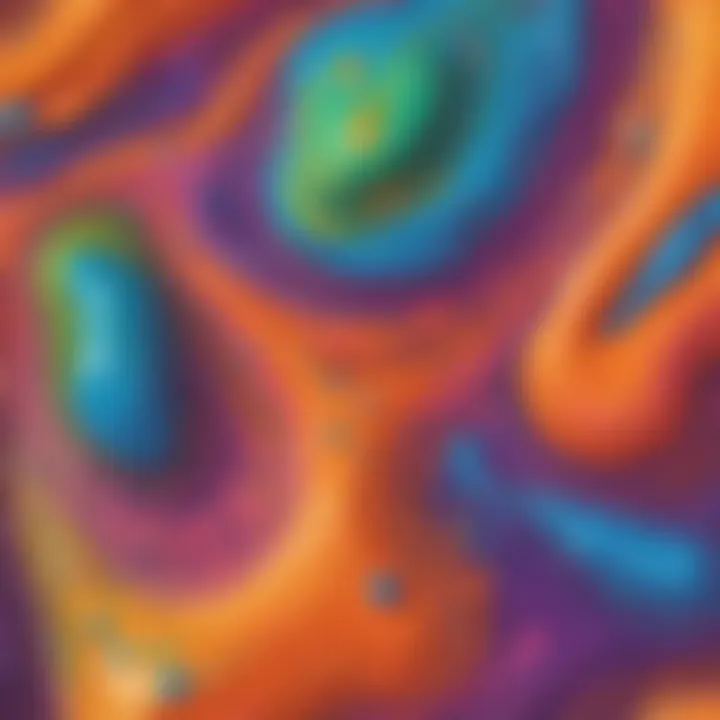
Science Fun Facts
Slime, that gooey and stretchy substance, has been fascinating kids and scientists alike for decades. Did you know that the word "slime" originates from Old English and refers to a sticky, viscous fluid? It's amazing how a mix of simple ingredients can create such a versatile material!
Discover the Wonders of Science
As we delve into the world of slime-making, we uncover the magic of polymer science. Polymers are long chains of molecules that give slime its unique properties. Through engaging experiments, children can witness firsthand how polymers interact to form this wonderful gooey substance.
Science Quiz Time
Are you ready for a slime-themed quiz challenge? Test your knowledge on the science behind slime with these thought-provoking questions: What ingredient acts as a binding agent in slime? How does temperature affect the consistency of slime? These brain teasers will get your scientific gears turning!
Science Experiment Showcase
Let's embark on a slime-making adventure! Gather your materials - including PVA glue, borax, and food coloring - and follow these step-by-step instructions to create your own colorful slime masterpiece. Remember to prioritize safety with precautions like wearing gloves and washing hands after handling chemicals.
Introduction
In this article, we delve into the fascinating world of slime-making, presenting a step-by-step guide tailored for young Science Buddies eager to embark on a fun and educational journey. Crafting slime at home is not only an engaging activity but also a scientific experiment that sparks curiosity and creativity in children. By understanding the process of making slime, kids can explore chemical reactions and sensory experiences, fostering a deeper appreciation for science and experimentation.
What is Slime?
Slime, in simple terms, is a viscoelastic substance that exhibits properties of both liquids and solids. When combined, the base ingredients react to form a gooey and malleable material that can stretch, twist, and mold. This unique characteristic of slime makes it a versatile medium for play and exploration, offering endless possibilities for creativity and sensory engagement.
Importance of Making Slime
The act of making slime goes beyond just a recreational activity; it serves as a hands-on learning experience for children. By engaging in the process of creating slime, kids can develop essential skills such as following instructions, measuring ingredients, and observing chemical transformations. Moreover, slime-making encourages problem-solving and critical thinking as children experiment with different textures, colors, and additives to achieve desired outcomes. This tactile experience not only entertains but also educates, making slime an ideal tool for promoting STEM education in a fun and interactive way.
Safety Precautions
While slime-making is a safe and enjoyable activity, it is essential to observe certain precautions to ensure a risk-free experience. Always supervise children during the process to prevent accidental ingestion of ingredients. Some components, such as borax or contact lens solution, may cause irritation if in contact with eyes or skin; hence, it is advisable to use protective gear like gloves and goggles. Additionally, ensure the workspace is well-ventilated to avoid inhalation of fumes. By prioritizing safety measures and responsible handling of materials, you can make slime-making a secure and enjoyable venture for young scientists.
Ingredients
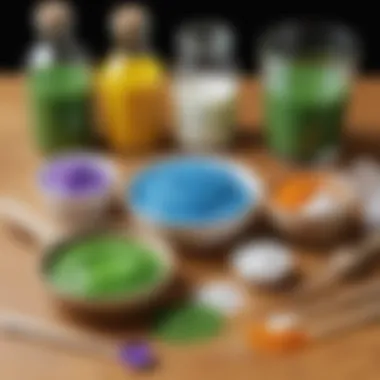
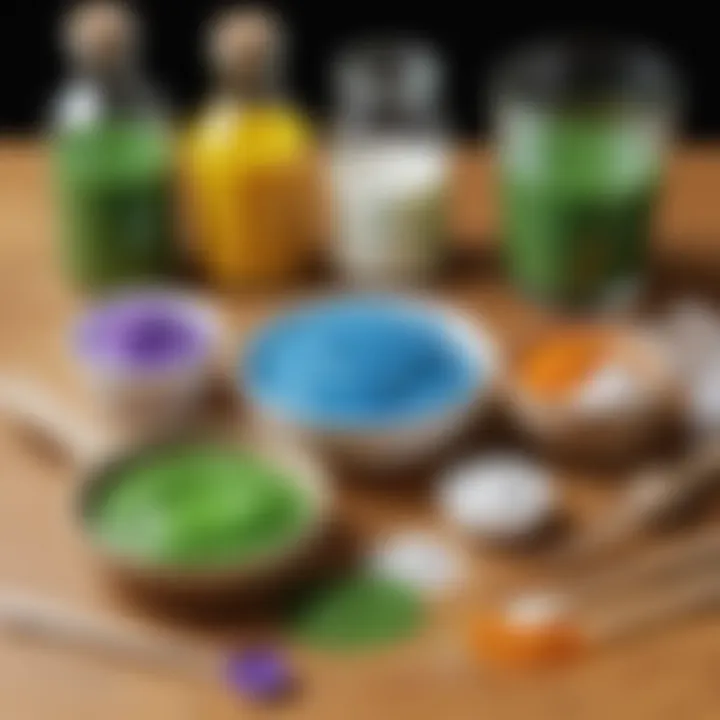
When it comes to making slime at home, the choice of ingredients plays a crucial role in determining the texture, stretchiness, and overall quality of the final product. In this guide, we will delve into the significance of each component, outlining their specific roles and contributions to the slime-making process.
Base Ingredients
Three fundamental ingredients form the base of most slime recipes: glue, borax, and contact lens solution. Each of these elements brings unique properties that are essential for creating the desired consistency and look of the slime.
Glue
Glue serves as the foundation of slime, providing the necessary stickiness and bonding properties required to hold the ingredients together. Its key characteristic lies in its adhesive nature, allowing the other components to bind effectively. One of the main advantages of using glue in slime-making is its ability to create a stretchy and moldable texture, making it a popular choice among DIY slime enthusiasts. However, one potential disadvantage of glue is the risk of creating a mess if not handled carefully.
Borax
Borax is a common activator in slime recipes, responsible for cross-linking the glue molecules to give the slime its characteristic elasticity. Its primary feature is its role in transforming the liquid glue into a solid, yet flexible material. The benefit of using borax lies in its effectiveness in creating smooth and less sticky slime, making it a preferred option for achieving the desired slime consistency. However, a word of caution is warranted due to the potential skin irritation that borax can cause in some individuals.
Contact Lens Solution
Contact lens solution is an alternative activator that can be used in place of borax for those who prefer a borax-free slime recipe. Its main characteristic is its saline content, which helps bind the ingredients together and create a cohesive slime mixture. The advantage of using contact lens solution is its accessibility and ease of use, making it a convenient choice for individuals avoiding borax. However, it is essential to carefully check the ingredients in the solution to ensure it contains the necessary components for slime-making.
Optional Add-ins
In addition to the base ingredients, optional add-ins such as food coloring, glitter, and scented oils can be incorporated to enhance the visual appeal and sensory experience of the slime.
Food Coloring
Food coloring offers the possibility to customize the slime's hue, allowing for a wide range of vibrant and eye-catching colors. Its key characteristic lies in its ability to mix seamlessly with the slime mixture without altering the texture or consistency. The advantage of using food coloring is the opportunity to create unique and personalized slime shades, adding a creative touch to the homemade slime. However, excessive use of food coloring may stain hands and surfaces, requiring caution during the coloring process.
Glitter
Glitter is a popular choice for adding sparkle and glamour to slime, transforming it into a dazzling sensory experience. Its main feature lies in its reflective properties, which catch and reflect light, enhancing the visual appeal of the slime. The advantage of using glitter is the ability to create mesmerizing and attractive slime designs, making it a favored option for those looking to elevate their slime aesthetics. However, glitter may pose a mess and cleanup challenge, necessitating careful handling to avoid dispersion.
Scented Oils
Scented oils introduce fragrance to the slime, offering a multisensory experience that engages both the olfactory and tactile senses. The key characteristic of scented oils is their aromatic properties, which infuse the slime with pleasant smells, adding a new dimension to the sensory play. The advantage of using scented oils is the opportunity to customize the slime's scent, creating a relaxing or invigorating sensory experience during slime play. However, individuals with sensitivities to fragrances should exercise caution when using scented oils to prevent allergic reactions.
Equipment Needed
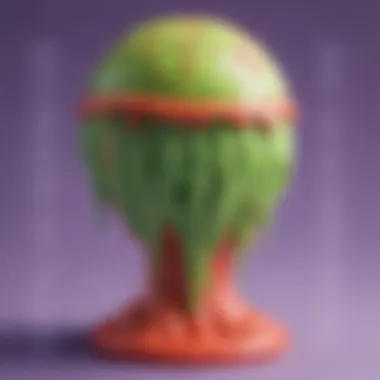
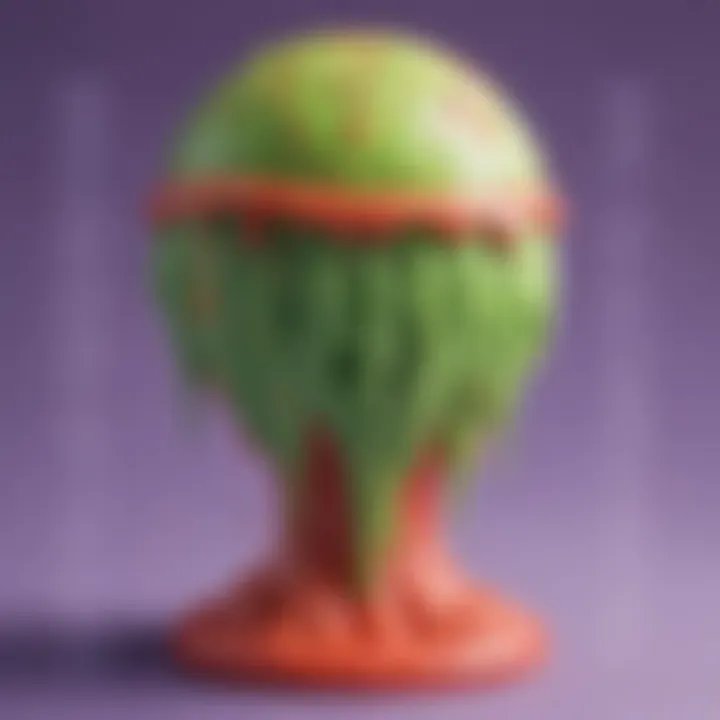
When embarking on the delightful journey of slime-making, it is crucial to have the right equipment at your disposal to ensure a smooth and successful crafting experience. The equipment needed serves as the backbone of your slime-making adventure, playing a fundamental role in manipulating and mixing the ingredients effectively.
First and foremost, a sturdy mixing bowl is essential to combine all the components of your slime seamlessly. Choose a bowl that is spacious enough to accommodate the ingredients comfortably without causing any spills or mess. Opting for a bowl with a non-porous surface can also make cleaning up afterward a breeze.
In addition to a mixing bowl, a reliable stirring tool is a must-have for ensuring thorough amalgamation of the ingredients. A wooden or silicone spatula works well for this purpose, allowing you to scrape the sides of the bowl and mix the components evenly to achieve the desired consistency.
Furthermore, measuring cups and spoons are indispensable for accurate and precise measurement of the various ingredients used in slime-making. Whether it is glue, borax, or contact lens solution, having the right measurements is vital to achieve the perfect slime texture.
Lastly, don't forget to have a designated storage container ready to preserve your slime creation. Airtight containers or resealable bags can help maintain the freshness and longevity of your slime, preventing it from drying out or becoming too sticky.
By ensuring you have the necessary equipment on hand, you set yourself up for a seamless and enjoyable slime-making experience, allowing you to craft colorful and captivating slime creations with ease.
Preparation
In the process of crafting slime, the stage of preparation holds utmost significance. Successfully preparing the key ingredients and materials beforehand streamlines the actual making of the slime, making the entire experience more organized and efficient. By carefully arranging your workspace and having all necessary tools and components at hand, you can ensure a smooth and enjoyable slime-making session without interruptions. Additionally, preparing ahead allows you to focus on the creative aspects of slime-making, such as experimenting with colors and textures, rather than scrambling to gather supplies. Considering the safety precautions and ensuring a well-ventilated area for making slime is essential during this phase. By committing to thorough preparation, you set the stage for a successful slime-making endeavor.
Creating the Base Mixture
The creation of the base mixture serves as the foundation for any slime recipe. This step involves combining the primary ingredients, such as glue and activator (like borax or contact lens solution), to form the basic slime texture. The base mixture is where the magic begins as the chemical reactions between the ingredients start to transform the mixture into the desired slime consistency. It is crucial to follow the recipe guidelines meticulously to achieve the perfect balance of ingredients for optimal slime texture. Stirring the mixture thoroughly and ensuring a uniform distribution of components are vital during this stage to prevent lumps or uneven consistency in the final slime product.
Adding Color and Texture
Once the base mixture is prepared, the next exciting step in slime-making is adding color and texture to customize the slime according to personal preferences. Incorporating food coloring not only enhances the visual appeal of the slime but also offers an opportunity for creative expression. Experimenting with different color combinations enables you to create unique and vibrant slime creations. In addition to color, adding texture elements like glitter or scented oils can elevate the sensory experience of playing with slime, making it more engaging and enjoyable. Carefully blending in these optional add-ins ensures a well-balanced and visually appealing slime that captures attention and provides a delightful tactile experience.
Mixing Process
When it comes to the essence of creating slime, the Mixing Process takes center stage. This pivotal step involves combining the base ingredients with optional add-ins to achieve the desired consistency and texture that make slime so irresistibly fun. The specialized art of mixing enables the components to interact harmoniously, resulting in a cohesive and stretchy end product that delights both the eyes and the touch.
A critical element to consider during the Mixing Process is the importance of precise measurements. Whether it's the amount of glue or the ratio of borax to water, accuracy is key to ensuring the slime turns out just right. Encouraging young aspiring scientists to carefully measure and mix teaches them valuable lessons in following instructions and understanding the scientific method.
Moreover, the Mixing Process serves as a prime opportunity to introduce scientific concepts such as polymerization and chemical reactions to budding minds. As the ingredients blend together, children can witness firsthand how different substances interact to form a new material with unique properties. This hands-on experience not only entertains but also educates, making slime-making a fascinating gateway to the world of chemistry.
Additionally, the Mixing Process encourages creativity and experimentation. As children engage in the tactile task of mixing, they can explore variations in mixing times, observe how different ingredients change the slime's consistency, and even hypothesize about the outcomes of their mixing techniques. This imaginative aspect of slime-making fosters critical thinking and problem-solving skills, nurturing young minds in a stimulating and enjoyable manner.
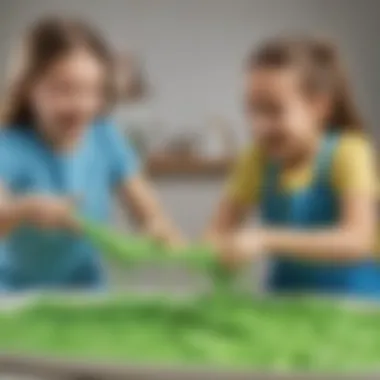
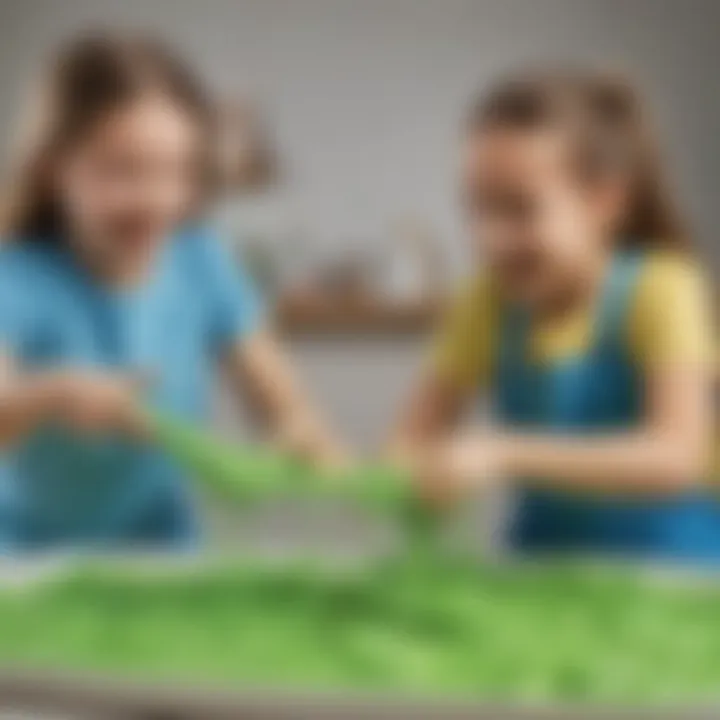
Final Touches
In the thrilling journey of creating your own slime from scratch, the final touches hold significant importance, as they are the finishing steps that enhance the overall look, feel, and sensory experience of your slime creation. Paying attention to these final details elevates the outcome, turning it from a basic DIY project into a work of art that reflects your creativity and precision.
The Significance of Final Touches
Final touches encompass a range of elements that bring your slime to life. From the texture you choose to the way you store it, these details can make a world of difference in the quality and longevity of your slime. Considerations like color intensity, scent infusion, and even glitter distribution play a vital role in customizing your slime to suit your preferences.
When adding final touches, you have the opportunity to experiment and achieve the desired consistency, stretchiness, and appearance of your slime. Whether you opt for a glossy finish, a matte look, or a multi-colored swirl effect, these final steps allow for personalization and the expression of your unique style.
Benefits of Perfecting Your Slime
By focusing on the final touches, you not only enhance the visual appeal of your slime but also improve its tactile properties. Smoothing out any air bubbles, ensuring an even distribution of additives like glitter or beads, and creating a uniform color tone all contribute to a more satisfying sensory experience when playing with your slime.
Additionally, paying attention to storage tips as part of the final touches ensures that your slime remains fresh and enjoyable for an extended period. Properly storing your slime in airtight containers, away from direct sunlight and excessive heat, preserves its texture and prevents it from drying out or becoming sticky.
Considerations and Precautions
While adding final touches, it is essential to maintain a balance between creativity and practicality. Avoid overloading your slime with additives, as this can affect its slimy consistency and lead to a less enjoyable play experience. Furthermore, be cautious when using scented oils or other fragrances, as some individuals may have sensitivities or allergies to certain ingredients.
Storage Tips
When it comes to making slime, proper storage is key to ensuring its longevity and reusability. Storage tips play a crucial role in preserving the quality of your slime for future fun 😄. By following these simple yet effective tips, you can make sure your slime stays in prime condition for extended periods.
First and foremost, always store your slime in airtight containers to prevent it from drying out. This step is essential in maintaining the desired stretchy and gooey consistency 🟢. Opt for containers with secure lids that seal tightly to lock in the moisture and keep contaminants out. Mason jars or reusable plastic containers work well for this purpose, offering a practical and convenient storage solution.
Furthermore, storing your slime away from direct sunlight is vital to prevent color fading and texture alteration. Exposure to sunlight can cause your slime to lose its vibrant hues and become brittle or sticky. Find a cool, dark place to store your slime, such as a cupboard or drawer, to shield it from harmful UV rays 🌞.
In addition to proper sealing and UV protection, consider keeping your slime at room temperature for optimal consistency. Extreme temperatures can adversely affect the quality of your slime, leading to either hardening or excessive stickiness. Avoid storing your slime in hot or cold environments, and aim to maintain a moderate room temperature to preserve its elasticity and playability.
To enhance the shelf life of your slime and prevent contamination, always wash your hands before handling it and avoid leaving it exposed to dust or debris. Cleanliness is key in ensuring that your slime remains safe and enjoyable to play with over time. Encourage proper hygiene practices when interacting with slime to extend its usability and avoid any potential mold growth or unpleasant odors.
Conclusion
In wrapping up this meticulous journey into the world of slime-making, it becomes evident that the significance of this endeavor extends beyond mere playtime. Through creating slime, children not only engage in a sensorial and tactile experience but also delve into the realms of science and creativity. The hands-on nature of making slime fosters curiosity and learning, sparking an interest in chemistry and experimentation. By following the step-by-step process outlined in this guide, young minds can develop essential motor skills and coordination, all while exploring the fascinating properties of polymers and substances.
Moreover, making slime serves as a bonding activity for children and their parents or caregivers. It offers a unique opportunity for quality time spent together, fostering communication and collaboration as they embark on a shared creative project. As youngsters experiment with different colors, textures, and scents, they not only enhance their sensory perception but also cultivate an appreciation for art and aesthetics. The excitement and satisfaction that come from successfully concocting their custom slime creations contribute to a sense of accomplishment and pride.
Furthermore, the safety precautions emphasized throughout this guide underscore the importance of responsible experimenting. Children learn the value of following instructions, handling materials carefully, and respecting boundaries when engaging in scientific endeavors. These lessons in precaution and mindfulness instill good habits early on, ensuring that the joy of slime-making is always paired with a sense of responsibility.
In essence, the exploration of making slime transcends being a mere pastime. It serves as a gateway to a world of discovery, learning, and fun, merging play with education in an enriching and entertaining manner. By embarking on this slime-making journey, young Science Buddies not only create whimsical concoctions but also nurture their inquisitive minds, fostering a love for experimentation that extends far beyond the realms of their homemade slime. This guide stands as a testament to the magic that unfolds when science, creativity, and curiosity intertwine in the hands of young explorers. Let the slime-making adventures begin!







